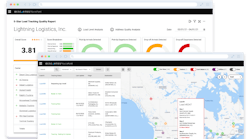It’s probably an understatement to say that all eyes have been on the second largest global economy lately. And as the second largest importer of goods and commercial services, investors around the world are scrutinizing every move that Beijing makes. That being said, the financial market is not the only entity keeping an eye on China right now. The U.S. International Trade Commission (ITC) voted to put tariffs on passenger and light truck tires last year as an anti-dumping measure. The resulting duties raised the price on Chinese tires for importers and subsequently reduced the number of tires being brought in from China.
Unfortunately, the ITC did not take any steps to protect the domestic truck tire market. Unlike North American manufacturers that base production levels on projected demand, manufacturers in China take a different approach. For example, a Chinese exporter of biomechanical materials was quoted in The Wall Street Journal as saying that the Shanghai government promised him a bonus if he raised exports by $1 million. In other words, his business doesn’t have to be profitable because the government will give him the money.
A few years ago at a tire conference in Europe, I had the opportunity to spend a few minutes with an expert on the Chinese tire market. As he explained how the government incentivized manufacturers to increase production without regard to the supply and demand model, I couldn’t help but think it could lead to issues. Lo and behold, recent events in the financial markets are reflecting the concerns about China’s economic policies.
Tire dealers and retreaders in North America have been experiencing the effects of the Chinese tire market for years. Low-cost radial truck tires continue to flood the market. According to one report, new truck tire capacity in China is about 120 million. The total new truck tire replacement market in the U.S. is less than 20 million, which is a lot more than the domestic demand in China. This means the pain is being felt around the world, especially in the European Union, as manufacturers are forced to find a place for millions of truck tires.
Since some of the Chinese tire companies are mostly concerned about production, performance and profit become an afterthought. When the government is willing to pay the manufacturers to maintain or increase export levels, there is less incentive to make a quality product.
On the other hand, North American tire manufacturers do not have that luxury, so they must base production levels on projected demand in order to maintain any hope of remaining profitable. While they are closing or consolidating plants to keep supply in line with demand, some of their counterparts on the other side of the world just keep pumping out the tires with little regard for quality control or the laws of economics.
The temptation to save a few hundred or a few thousand dollars on low-cost Chinese imports is difficult to resist. In some cases, there will be incredible value; in others, it could be a borderline safety hazard. Since federal truck tire testing requirements are not policed or enforced, fleets will just have to trust that every tire with the letters DOT molded on the sidewall meets the regulation. Likewise, the retreadability of the casing will be equally hit or miss.
When it comes to truck tires, you usually get what you pay for. As long as the Chinese government is able to subsidize the tire manufacturing industry, the quality of those products will vary.


